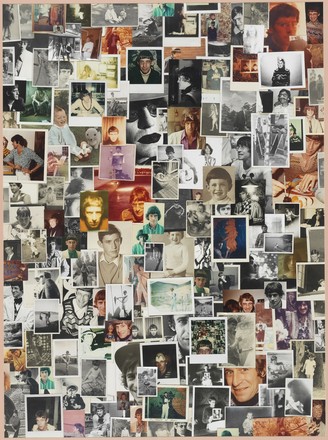Self portrait 1979
1979
Montage of photographic prints
Purchased 1989
Artist Justin O’Brien, who was Sharp’s school teacher, introduced him to the work of Vincent Van Gogh, the painter who would become his biggest artistic influence. Van Gogh’s dream of a utopian artist’s settlement was Sharp’s inspiration for the Yellow House, an art collective he co-founded in Kings Cross in 1970. Each room in the Macleay St terrace was an artwork in itself, and the Yellow House has become a celebrated piece of Sydney’s artistic history.
“From his schooldays to the end of his life… Sharp, turned
images that might seem trivial or ephemeral into monuments"
John McDonald, Sydney Morning Herald Tuesday December 3, 2013
"You work for the public, you never probably meet. It’s tough
for the people you actually know. You give more loyalty to the audience you don’t know. That is
the position of being an artist."
Martin Sharp interviewed by Nick Waterlow, The everlasting
world of Martin Sharp: paintings from 1948 to today, 2006, p24
Singer and ukulele
player Tiny Tim was a recurring motif in Sharp’s art and his home was filled
with images of the performer, who had a surprise hit with Tiptoe Through The Tulips. His star burned brightly for
a moment in the late ‘60s but was soon relegated to what Sharp calls “the outer
suburbs of show business”. Sharp laboured for more than a decade perfecting
his Tiny Tim tribute film project, Street of Dreams.
Sharp was
honoured with an Order of Australia in 2005 for services to the pop art
movement.
“I
think artists taking awards is a bit risky because it might influence your
work, but the postie who delivered the letter said I had to accept it and
so I took his advice,”
The unreleased
movie Hippie Hippie Shake, starring Sienna Miller and Cillian Murphy, was the adaptation
of Richard Neville’s 1995 book of the same name. It tells the story of Oz, the
groundbreaking magazine launched in Sydney in 1963 by Sharp, Neville and
Richard Walsh, and resurrected in London in 1967. Sharp was its art director, producing
collages, paintings and satirical cartoons that combined elements of social
commentary, high art and pop culture. Sharp was vocal about the movie
saying “My character was involved in 55 scenes, none of which happened.”



 Back to list
Back to list